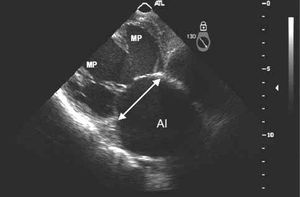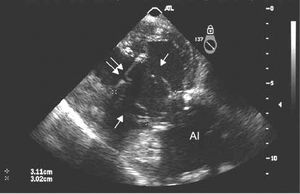Ischemic mitral regurgitation (IMR) is a common complication of coronary disease that doubles postinfarction mortality. The main mechanism of IMR is left ventricular remodeling, which results in dilation of the mitral ring and displacement of the papillary muscles (PM). Reductive annuloplasty, the standard reparative technique used, leads to a large percentage of recurrences; hence, other techniques that act on ventricular remodeling are required.
We present the case of a 61-year-old patient who came to the hospital for symptoms of congestive heart failure. A diagnosis of asymptomatic inferolateral infarction was established, with decreased injection fraction and severe mitral regurgitation, secondary to mitral ring dilation and distortion of the ventricular geometry with PM displacement (Figure 1). The patient was referred for complete revascularization surgery and mitral valve repair.
Figure 1.
In addition to revascularization surgery, annuloplasty with a Duran flexible ring (27-mm) was performed. To reestablish the ventricular geometry, a second flexible ring (29-mm) was implanted at the level of the PM, and the interpapillary distance was corrected to 27 mm (double arrows). In addition, neo-chords (arrows) were inserted from the PM to the trigones to adjust the mitral ring-to-PM distance. Following mitral repair and re-establishment of ventricular geometry, the absence of mitral regurgitation was confirmed by transesophageal echocardiography (Figure 2).
Figure 2.



